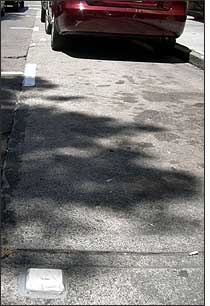In a study to determine how street parking spaces are being used, and whether drivers are paying for them, the Port of San Francisco, in conjunction with the city’s Municipal Transportation Agency (MTA), has deployed a network of active wireless sensors that detect where and when cars are parked.
The port launched a pilot in August 2006, using hardware, software and data management provided by Streetline Networks to track when cars were parked in 250 spaces in an area surrounding Fisherman’s Wharf and the Embarcadero. The system tracked when cars left the spaces, and compared occupancy information with actual money received to determine if parking was being paid for. In June 2007, the city installed 30 additional sensors at metered parking spaces on the 500 block of Columbus Avenue, in North Beach. The pilot involving 250 sensors deployed at Fisherman’s Wharf and the Embarcadero ended March 2007, but the 30 sensors on Columbus Avenue will remain in use until the end of this month.
Streetline’s sensors contain wireless networking components made by Dust Networks, based in Hayward, Calif. The sensors are housed in a plastic covering similar in size and shape to reflectors often embedded in streets, and affixed to the pavement with standard pavement epoxy, one per parking space. The devices contain an ultralow-power transceiver operating at either 2.4 to 2.5 GHz or 902 to 928 MHz, and are powered by a battery sufficient for five to 10 years of operation, says Tod Dykstra, Streetline’s CEO and a cofounder of Dust Networks. The sensors transmit their location and identification number, as well as parking-related data via Dust Networks’ proprietary Time Synchronized Mesh Protocol (TSMP), used by the sensors to communicate with one another and with the gateway receivers.
When a sensor detects a car is occupying its assigned parking space, the device transmits that information through the mesh network of sensors until it reaches a Streetline gateway, typically mounted on a lamppost. The gateway routes the data to an Internet server via a cellular connection. Once the car leaves, the sensor transmits data indicating the space’s vacancy. The same sensors can also detect traffic patterns in adjacent lanes, providing the city with details about the amount of traffic passing through the area at any given time. Streetline’s software system analyzes the data and provides real-time and summary reports to the city of San Francisco over a Web interface.
“We can determine the number of spaces that are occupied or unoccupied,” says Bryant Woo, an associate engineer at San Francisco’s Department of Parking and Traffic. That data enables the city to determine where and when parking usage is greatest, when a higher price for parking might be appropriate, and where and when drivers fail to pay for their parking time. The city can then send additional parking enforcement officers to specific locations at certain times of the day or week, as needed.
At some locations, the port and city are shifting from coin-only parking meters to models that also accept paper money or even credit cards. The switch is being driven by San Francisco’s rising cost of parking, which ranges from $1.50 to $3 per hour. At that rate, Woo points out, it is difficult for drivers to provide enough change for a coin-only meter. The sensor system provided the city with details regarding how the new meters affected drivers’ use of those parking spaces.With this data, Woo says, the city can review occupancy and turnover rates and decide if time limits need to be changed. Streetline has provided the city with graphical illustrations of parking usage in particular areas, indicating how long spaces remained vacant, and when.
The Streetline system can be electronically linked to the parking meters, enabling the city to obtain real-time information about each meter’s operating status and the amount of money it contains. According to Dykstra, “In addition to data collection, we also provide service that controls the parking meter. For example, we’re able to remotely reset a parking meter that is in a failed state, which can dramatically reduce maintenance costs.” To date, however, San Francisco has not chosen to use that option.
Woo says the city intends to remove the final 30 sensors from parking spaces at the end of September, and then study the pilot’s results. Eventually, he states, he would like to see a system in which customers can pay for parking via cell phone, by calling the system and inputting money into an account. He hopes to one day establish a system allowing customers to pinpoint empty parking spaces via their vehicle’s GPS system and a Web-based server. At this time, though, the city has no immediate plans to test such a system.
The city of Los Angeles also tested the Streetline system in its Toy District, in a 100-space pilot conducted this year from April to mid-August.
“It’s really been a remarkable success, and very gratifying to see,” Dykstra says of the two pilots. “Parking is a very complex social activity, and a huge factor in local economies. As drivers, we mostly just think of it as a frustrating experience to be forgotten as soon as possible, but it’s really a fascinating model for how people share scarce resources in the public sphere, and how accessibility impacts things like retail sales, land use, commercial real estate values and quality of life in cities.”
Streetline’s standard pricing is $300 for each sensor and $150 for each meter monitor, including installation, and a $10 monthly service fee per device.




